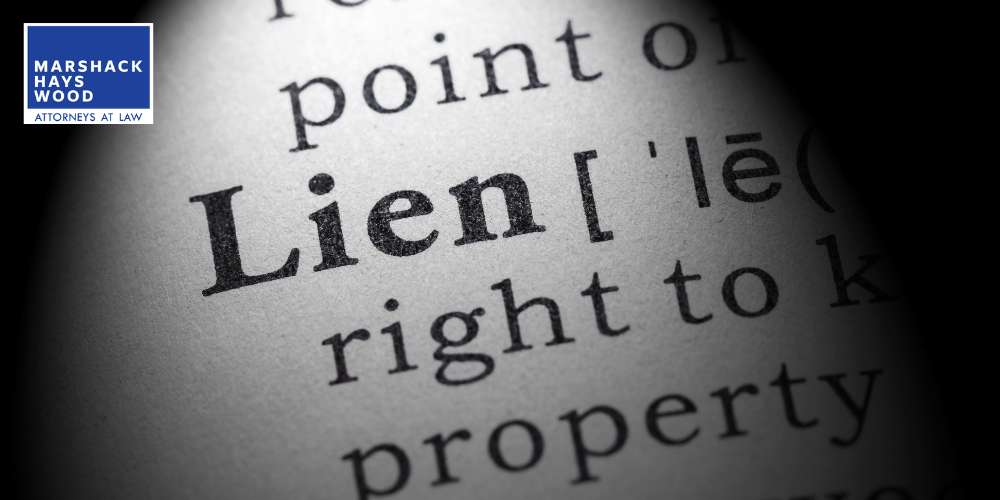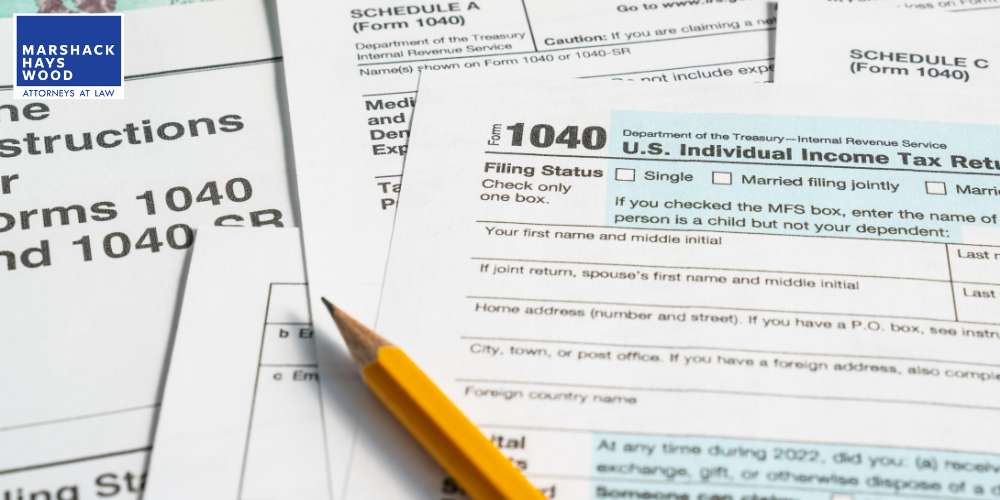Tax Lien Removal Attorneys in Orange County, CA
Home » Tax Lien Removal
Practice Areas
Tax Lien Removal After Bankruptcy in California

Emerging from bankruptcy is a significant accomplishment, but the shadows of past financial challenges, like state and federal tax liens, can linger even after you receive your discharge. Tax liens can impact creditworthiness, hinder property transactions, and cause ongoing financial problems even after bankruptcy.
If you are seeking a comprehensive financial recovery beyond bankruptcy, the Orange County bankruptcy attorneys at Marshack Hays Wood are here to help. We can help you understand the process of removing a tax lien from your property after bankruptcy and provide you with personalized assistance every step of the way.
Call us at (949) 333-7777 to schedule a free consultation with a member of our team.
How to Remove a California State Tax Lien
A state tax lien can impact your financial standing as well as your abilities as a property owner, which is why it’s important to understand how tax liens work and how to effectively remove them. Before delving into the removal process, it is essential to understand what a state tax lien entails, how it differs from an IRS tax lien, and why it is important to remove it.
What is a State Tax Lien?
A state tax lien is a legal claim imposed by a government entity on a property when the property owner fails to pay their state taxes. This lien serves as a security interest for the government to ensure the eventual payment of the outstanding tax debt. State tax liens can be placed on real estate, personal property, or financial assets owned by the individual or business that owes a tax debt to the state.
When a state tax lien is filed, it becomes a public record, alerting creditors and other interested parties that the property is subject to a claim due to unpaid taxes. This can impact the property owner’s ability to sell or transfer ownership of the property until the tax debt is settled. In some cases, the government may choose to seize and sell the property to recover the unpaid taxes if the owner continues to neglect the outstanding debt.
While bankruptcy provides individuals with a fresh financial start, tax liens can survive the bankruptcy process and continue to hurt the property owner financially. Bankruptcy can have different effects on state tax liens depending on the specific chapter of bankruptcy filed and the nature of the tax debt.
In a Chapter 7 bankruptcy, certain unsecured debts may be discharged, potentially including income tax debts. However, tax liens that are secured by property may survive the bankruptcy process, making the property owner unable to sell or refinance the property until the tax debt is satisfied. In a Chapter 13 bankruptcy, however, individuals can include tax debts in a court-approved repayment plan, which can allow them to settle the debt over time.

State Tax Lien vs. IRS Tax Lien
The primary distinction between a state tax lien and an IRS tax lien lies in the jurisdiction and level of government involved. State tax liens are imposed by individual state governments, while IRS tax liens are enforced by the federal government in the United States.
State tax liens are related to unpaid state taxes, such as income taxes, property taxes, or sales taxes. They’re also specific to the state in which the taxes are owed, making them subject to that state’s laws and regulations.
On the other hand, IRS tax liens are associated with federal income taxes owed to the U.S. government. If you receive a Notice of Federal Tax Lien, it means that you likely have unpaid federal income taxes that need to be paid.
While both state and IRS tax liens serve the purpose of securing unpaid taxes, they operate independently of each other. If you have both a state tax lien and a federal tax lien on your property, even after bankruptcy, it’s essential that you address both liens as soon as possible to avoid potential financial penalties.
Why is it Important to Remove State Tax Liens?
It is crucial to have a state tax lien removed for several reasons. Firstly, tax liens are put on a property owner’s public record. The presence of a tax lien on someone’s public record is a red flag for creditors, signaling that they may be financially unstable, which can make it difficult for them to secure loans or credit.
Additionally, a state tax lien can hinder a property owner’s ability to sell or refinance their property. Since the government has claimed an interest in the property, the property owner no longer has complete control over their property. Removing the lien is essential for restoring financial flexibility and maintaining control over one’s assets.
State tax liens can lead to legal consequences, including the potential seizure and sale of the property by the government to recover the unpaid taxes. Resolving and removing these tax liens can help mitigate the negative effects of the lien, ensuring the property owner has the ability to regain control of their financial future.
Tax Lien Withdrawal vs. Tax Lien Release
The terms “tax lien withdrawal” and “tax lien release” refer to distinct processes associated with resolving tax liens, each with its own implications. A tax lien withdrawal occurs when the government agency that filed the lien decides to remove it from public records. In essence, a withdrawal erases the lien as if it never existed, providing a clean slate for the affected individual or business.
On the other hand, a tax lien release signifies that the taxpayer has satisfied the debt. The release is a way for the government to officially acknowledge that the taxpayer has fulfilled their tax obligations. This is often given after the outstanding taxes are paid, either through a lump sum or a negotiated settlement. Once the debt is settled, the government releases the lien, allowing the taxpayer to regain control over their property without any encumbrances.

State Tax Lien Removal in California
Removing a state tax lien from public record requires a strategic and comprehensive approach, which can be rather complicated. For tailored guidance, the California bankruptcy attorneys at Marshack Hays Wood can help ensure you are able to reach a smooth and effective resolution regarding your tax debts. We can guide you through the process of removing the tax lien from your public record, ensuring you can continue moving forward with your life, even in the wake of a bankruptcy proceeding.
How to Remove a State Tax Lien from Public Record
Firstly, it’s essential to satisfy the outstanding tax debt by paying the owed amount to the California tax authorities. This can often be done through a lump sum payment or by negotiating a settlement arrangement.
Once the tax debt is paid in full, the next step is to contact the California Franchise Tax Board (FTB). The FTB will release the state tax lien once you’ve filed any missing tax returns, paid the debt, and contacted them providing documentation regarding your tax filing requirements. If you can prove that you have no filing requirements for the liened tax year, they will issue a release, removing the lien from your public record.
Does a State Tax Lien Appear on your Credit Report?
No, tax liens no longer appear on credit reports, thanks to changes made by the three major credit reporting bureaus back in 2018. However, since they appear on your public record, tax liens can still affect your ability to get approved for credit. If you are looking to build credit after filing bankruptcy, it’s crucial that you address your tax liability as soon as possible.

How to Remove a Tax Lien in California
There are a few ways that property owners can remove a tax lien from their property in California, including appealing the lien, having the lien released, or having the lien withdrawn. In each of these processes, it’s important to seek professional advice from tax experts or legal professionals who can help ensure you are able to successfully remove the lien from your assets.
Appeal the Tax Lien
If you have fulfilled your tax responsibilities, but you have received a Notice of State Tax Lien anyway, you can appeal the decision to the California Office of Tax Appeals (OTA). Your letter of notice should provide you with steps to take if you disagree with the FTB’s decision, but the process normally involves filing a formal appeal with the OTA. It may also involve attending a Collection Due Process hearing with representatives of the OTA.
The appeals process can be overwhelming, but our attorneys at Marshack Hays Wood can provide you with legal representation every step of the way. We can help you file your appeal or even represent you in a hearing with the OTA, if necessary, ensuring you have the best chance of having your state tax lien withdrawn.
Have the Lien Released
The most effective way to have a tax lien removed from your property is to have it released. You can do this by satisfying the debt through a lump sum payment or a payment plan. Taxpayers may be able to pay their tax debt in installments through payroll deductions or a direct debit installment agreement, which withdraws monthly payments from their bank account.
Once the debt is satisfied, the FTB should automatically provide you with a lien release. However, if the lien is not automatically released, contact the FTB and provide them with documentation proving the debt has been satisfied.
Have the Lien Withdrawn
You may also be able to have your California tax lien removed if it is withdrawn. The state may withdraw a tax lien if it is filed incorrectly or if the debt has already been satisfied. You can contact the FTB and provide them with proof that you are current on your estimated tax payments. If they find that the Notice of State Tax Lien was filed incorrectly or erroneously, they may withdraw the tax lien, erasing it from your record.
Subordination Agreements
If someone has more than one lien placed against their property, they can agree to lien subordination, which can lower the priority of the tax lien in favor of other liens. While this doesn’t remove the lien from the property, it may allow the property owner to modify or refinance loans on their property if they can’t fulfill their tax obligations.
Avoiding State Tax Liens
In order to avoid financial penalties, taxpayers should do everything they can to avoid state and federal tax liens. The best way to do this? Prioritize timely and accurate payments on taxes. For state liens, that means fulfilling any state income, housing, and/or sales taxes. If you receive a tax bill, be sure to read it and make proper payments, if possible.
It’s also a good idea to stay informed about tax obligations, deadlines, and any changes in tax laws. Regularly reviewing and reconciling financial records can help identify potential issues before they escalate.
Another good way to avoid state tax liens is to seek legal counsel from a bankruptcy attorney. If you are struggling financially and want to avoid liens on your property, a bankruptcy attorney can help provide you with debt settlement options. These can allow you to fulfill your tax obligations and protect your record.
California Lien Release
A California tax lien release form typically includes essential information related to the release of a state tax lien on a property. The specific details may vary, but a comprehensive release form often includes things like personal identifying information, lien information, payment details, the date of release, and more.
It’s important for the property owner to carefully review and ensure the accuracy of the information and notify the FTB if there are any errors or mistakes. Once completed, the form is typically filed with the county recorder’s office to officially remove the tax lien from public records associated with the property. Property owners seeking a lien release should consult with tax professionals or legal counsel to navigate the process effectively.
Federal Tax Lien Release
A federal tax lien release form, often referred to as IRS Form 668(Z), includes similar information to state lien release forms. It’s also important for these forms to be carefully reviewed for accuracy so you can dispute any errors.

Call a Tax Lien Attorney in Orange County Today
If you’re grappling with state tax liabilities after bankruptcy, you don’t have to fight alone. Our skilled attorneys can provide personalized solutions tailored to your unique situation. At Marshack Hays Wood, we understand the challenges individuals face when dealing with tax liens, and our seasoned bankruptcy attorneys in Orange County are here to guide you through the process.
Whether you need assistance in appealing the tax lien, having it released, withdrawn, or exploring subordination agreements, we have the knowledge and resources to navigate the intricacies of California state tax laws. With a wealth of experience in handling tax-related matters, our team is dedicated to helping clients regain control of their financial standing and property.
Call us at (949) 333-7777 or contact us online to schedule a free consultation with a member of our team.
READY TO GET STARTED?
At Marshack Hays Wood, our attorneys provide the legal support you need to move forward with confidence. Let us help you take the first step toward financial stability.
